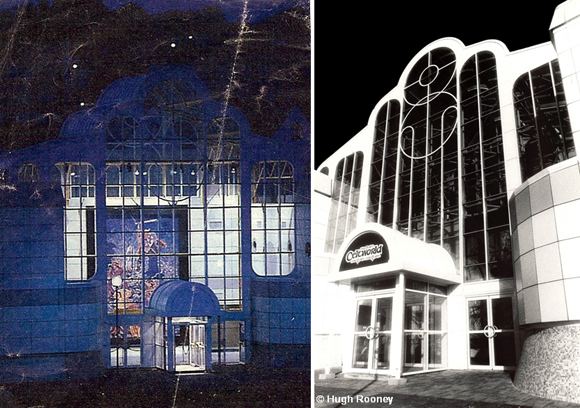Operated by Celtworld Limited Opened May 1992 | Total 1 Closed September 1995 | |
 | ||
Location Tramore, County Waterford | ||
Celtworld was an educational amusement park, heritage interpretation centre, and tourist attraction in Tramore, County Waterford, Ireland. It operated from 1992 to 1995 before closing due to financial difficulties.
Contents
Funding
The total start-up cost for the project was more than £4 million in Irish pounds (approximately €5 million). With building costs of between £90 and £110 per square foot, it was reputed to be the most expensive construction project in Ireland. Tramore Fáilte, an arm of the South East Regional Tourism Organisation, provided £737,000 toward start-up costs, in addition to term loans and leasing arrangements of approximately £575,000. The project also attracted a European Union Structure Fund Grant of £1.81 million.
Private sector investment of £1.5 million was provided by Vectravision, Kentz, and British firm International Tourism Projects Ltd. Bank loans provided a further £600,000 of capital. A further £230,000 was funded by 63 Business Expansion Scheme (BES) investors, which included employees of the Bank of Ireland, Kentz, and Tramore Fáilte. The 2.5 acre site was purchased from Tramore Fáilte for £400,000. The company was incorporated as Celtworld Limited on 30th November 1990, opening in May 1992 with 15 full-time and 15 part-time employees.
Design
The art deco interior was designed by artist Jim Fitzpatrick. The building was planned as a wet-weather attraction. It was clad with aluminium and was not air conditioned, which led to uncomfortable conditions in warm weather.
Theatre
Celtworld's main feature was a 25-minute show which involved a revolving auditorium, the largest such theatre in Europe at that time. Visual effects included animated artwork, computer-generated imagery, lasers, holograms, and animatronics. The theatre was presented as a "Crystal Time Chamber" which allowed visitors to travel back to Celtic times. Every turn of the revolving theatre brought visitors to 1 of 6 presentations, which involved a range of mythical and legendary characters such as a daughter of Noah, Tuatha Dé Danann, Fomorians, Partholón, Lugh, Balor, and Cú Chulainn. The experience was narrated by Tuan mac Cairill. Historical figures such as vikings and Saint Patrick were also included.
Otherworld
After the theatre show, visitors entered the interactive Celtic Otherworld exhibition. This area included quizzes, information on women in Irish mythology, ogham stones, Aos Sí, an £18,000 replica Book of Kells, and an artificial tree with talking animatronic human heads. The exit was via a gift shop.
Closure
Celtworld experienced early trading difficulties and a financial consultant was appointed to review the company. It received a loan from Bord Fáilte in late 1993 but business did not improve. Celtworld closed in September 1995 with losses of over £4 million. More than £2 million had been spent on set-up, promotion, and consultancy fees. The centre's failure has been attributed in part to its unchanging audiovisual presentations, which failed to attract adequate repeat visitors. Bord Fáilte Director General Malt McNulty claimed that the project's failure was due to its design as a wet-weather facility. Its opening season saw unseasonably warm, dry weather which led to low attendance.
Its failure led to discussion in Dáil Éireann, the Irish parliament, where Kathleen Lynch questioned the then Minister for Tourism and Trade, Enda Kenny about its closure. Bobby Molloy also questioned Kenny over the closure and allegations which had been made on the RTÉ One current affairs television shows Prime Time and Marketplace.
Aftermath
The property was placed on the market with the condition that it could only be used for tourism or leisure activities, which limited its potential sale price. The site went on sale in September 1995 at an asking price of £600,000 and was sold to a Northern Ireland consortium in January 1996 for £475,000. In 1997, the site was sold to Butlin's Mosney owner Phelim McCloskey for £380,000. McCloskey developed a robotic dinosaurs exhibit which closed after less than a year.
In 1999, McCloskey obtained planning permission for 30 short-term holiday apartments on the site. Permission was granted by An Bord Pleanála, controversially overruling a Waterford County Council decision to reject an original proposal for 36 apartments. In 2000, Ambient Catering Limited purchased the site and developed a 20,000 square feet music venue named South with a capacity of 2,200 guests, at a cost of €3 million. The venue opened in 2001 but closed soon afterwards.
Celtworld Limited was dissolved on 15th July 2005.
The site was sold in May 2006 to Volute Properties Limited, who received planning permission for a mixed-use development with Dunnes Stores as anchor tenants. This proposal fell through and the building was demolished in 2008.
A European Commission investigation was due to report in 1997 but as of 1999 had not been completed.
Media and popular culture
Celtworld was featured in the 1994 RTÉ Television short drama, Gypsies.
